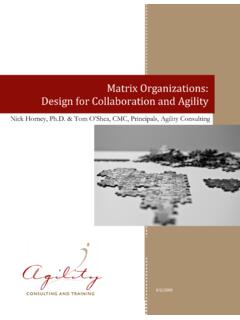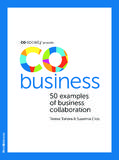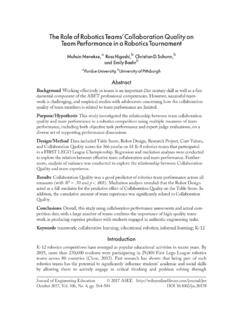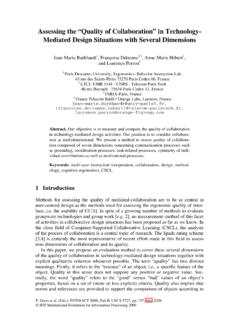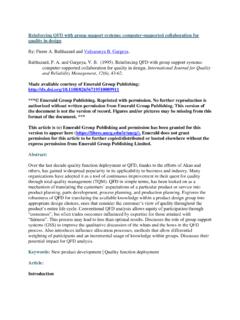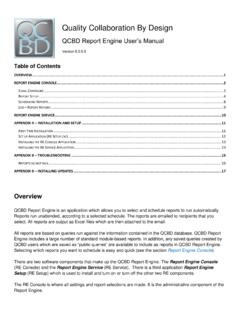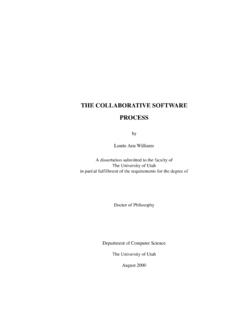Transcription of A Study Exploring the Relationship Between Collaboration ...
1 LEARNING WITH OTHERS A Study Exploring the Relationship Between Collaboration , Personalization, and Equity Executive Summary OCTOBER 2018 Wendy Surr, Kristina L. Zeiser, Olivia Briggs, and Kimberly Kendziora American Institutes for Research LEARNING WITH OTHERS: A Study Exploring the Relationship Between Collaboration , Personalization, and Equity Executive Summary 1 Study Rationale What does it mean to personalize learning? Does personalized learning look the same for all students? A personalized learning approach aims to offer learning experiences that customize education to an individual s personal needs and interests as well as connect the individual to adults and peers in a larger community of learners. i Although an important hallmark of personalized learning is addressing the full range of students learning needs, emerging trends suggest that personalization is often equated with individual learning. This approach to personalization often relies heavily on the use of technology to enable students to learn independently and progress at their own pace.
2 For many students, however, learning on their own in social isolation may not be an effective strategy for meeting their personalized learning needs. To truly personalize, we must recognize that students vary in their needs for social support and exchange. Providing collaborative learning opportunities is one educational strategy that could help meet a wider range of student learning needs, and has been associated with a range of benefits for students, from enhanced motivationii to a deeper understanding of core Educational approaches that emphasize personalization, but limit students opportunities for learning with others, also may have implications for equity. Research suggests that Collaboration may be especially important for addressing cultural learning differences and in meeting the needs of traditionally underserved The provision of rich social learning opportunities may be particularly important for Black students who have been shown to thrive when they have access to meaningful, challenging social learning If the current trend in personalized learning continues to emphasize individual learning, will we inadvertently be shortchanging the learning needs of those students who are already at a disadvantage?
3 Our Approach The aim of this Study was to examine how Collaboration is linked to personalization and explore racial/ethnic differences in experiences and benefits associated with Collaboration . The Study posed three research questions (see box). LEARNING WITH OTHERS: A Study Exploring the Relationship Between Collaboration , Personalization, and Equity Executive Summary 2 Research Questions What are the relationships among opportunities for Collaboration , classroom experiences, and outcomes, particularly for students who identify as Black? To what extent do students have opportunities to participate in high- quality collaborative learning experiences? What contextual, school-level factors do teachers identify as helping or hindering their ability to provide opportunities for high- quality Collaboration in diverse, student-centered classrooms? We designed a descriptive and correlational Study that took place within four high schools that had an explicit focus on personalization, offered regular opportunities for Collaboration , and served a diverse student body.
4 We collected data from six different sources during spring 2017: teacher and student surveys, teacher interviews, student focus groups, classroom observations, and student demographic and academic data. Our sample included 892 students, 138 teachers, and 30 classrooms within our four schools. We identified and measured a set of structural and dynamic elements associated with high- quality Collaboration . By structural quality , we mean those aspects of collaborative opportunities that are planned in advance by educators, such as in the design of activities or the intentional composition of collaborative groups. We use the term dynamic quality to refer to those aspects of collaborative opportunities that are realized in real-time as students engage in a collaborative task, interact with their peers, and respond to teacher facilitation strategies. Elements of High- quality Collaboration Structural quality Elements Student-centered, culturally responsive activities Activity requires group interdependence Balanced group composition Group norms and task clarity Dynamic quality Elements Responsive, respectful, and inclusive interactions Constructive exchange Shared leadership and decision making Our analyses of interview and focus group data included the identification of emergent themes from teachers and students.
5 Our quantitative analyses focused on student and teacher survey responses as well as classroom observation ratings. Using teacher survey data, we examined overall responses and tested for differences Between math and English language arts (ELA) Using student survey data, we studied overall associations Between our three factors of interest: opportunities for Collaboration , classroom experiences, and outcomes. We also tested whether these associations differed Between Black students and White Relationships Between factors were then classified as weak (below ), moderate ( Between and ), or strong (greater than ) depending on the strength of the LEARNING WITH OTHERS: A Study Exploring the Relationship Between Collaboration , Personalization, and Equity Executive Summary 3 We shared our initial findings with teachers, administrators, and other school staff at each of our four participating sites during half-day data forums. The nature of the questions posed, and the reflections and meaning derived from the results we shared, enabled us to identify areas for future research, broaden our interpretation of findings, and improve our communication of these results to maximize understanding of and use by school practitioners.
6 Our Findings Our Study offers further evidence of the benefits of Collaboration for student learning. In addition, our Study reveals some of the distinct ways in which Collaboration is linked to students perceptions of personalization in the classroom, and how Black students benefit from and experience Collaboration differently from White and other non-Black students. Our top 10 takeaways from the Study are listed below. Key Study Findings Relevant for All Students 1. Student reports of having opportunities for high- quality Collaboration were strongly associated with positive classroom experiences and higher engagement, motivation, and self-efficacy. 2. Student reports of high- quality collaborative experiences were positively and strongly associated with students perceptions of personalization and personalization, in turn, was strongly associated with outcomes. Students perceptions of personalization therefore served as a link Between high- quality Collaboration and outcomes.
7 3. High- quality collaborative experiences were weakly and positively linked to grades. However, the Relationship with grades was largely dependent on students mindsets and dispositions, such as engagement, self-efficacy, and intrinsic motivation. 4. Within classrooms, opportunities for constructive exchange among students ( , frequent and substantive discussion where students build off one another s ideas and explore areas of disagreement), were low overall, but were higher during collaborative groups than during other classroom activities. 5. Students and teachers in our Study reported more opportunities for high- quality Collaboration in ELA than in math classrooms. In addition, ELA teachers perceived more benefits and greater available support for Collaboration than did math teachers. 6. Teachers struggled to balance their interest in offering Collaboration with the perceived challenges of meeting the varying needs of their students during group work. LEARNING WITH OTHERS: A Study Exploring the Relationship Between Collaboration , Personalization, and Equity Executive Summary 4 Key Study Findings for Black Students 7.
8 Black students assigned higher ratings on surveys for many aspects of their collaborative experiences than did White students. 8. Student reports of high- quality Collaboration were positively associated with grades for Black students, regardless of their prior academic performance. For White students, high- quality Collaboration was no longer related to grades after accounting for prior academic performance. 9. High- quality Collaboration was positively linked to mindset and dispositional outcomes for both White and Black students. However, the ways in which high- quality Collaboration , classroom experiences, and outcomes were linked differed Between Black and White students. For instance, for White students, teacher expectations strongly and positively influenced the Relationship Between high- quality Collaboration and a range of outcomes. For Black students, teacher expectations had far less of an influence on the positive Relationship Between high- quality Collaboration and outcomes.
9 10. Students in the all-Black focus groups reported lower perceived relevance of collaborative activities, more frequent experiences of exclusion, stereotyping and marginalization, and lower perceived support from teachers for collaborative group work than did students participating in mixed-race focus groups. Implications for Schools and Educators Opportunities for high- quality Collaboration could be among the factors that help contribute to positive changes in the academic trajectory of Black students. We have new evidence that Collaboration is linked to higher grades for Black students, even when we accounted for prior grades. We did not find this same result for White students. These findings suggest that for Black students, having the chance to engage in high- quality collaborative activities may help boost academic success. Schools and educators interested in addressing equity issues should consider increasing opportunities for high- quality Collaboration as a potential strategy for maximizing success for students from varying backgrounds.
10 Collaboration is strongly linked to personalization. We have new evidence to suggest that student reports of Collaboration are strongly linked to students perceptions of personalization. Together, collaborative experiences and perceptions of personalization are both positively related to students mindsets and dispositions. Schools and educators interested in meeting the personalized learning needs of students as a strategy for enhancing learning outcomes should adopt a definition of personalization that includes social learning opportunities, and recognize that opportunities for Collaboration are strongly linked to students mindsets and dispositions, such as engagement, intrinsic motivation, and self-efficacy. LEARNING WITH OTHERS: A Study Exploring the Relationship Between Collaboration , Personalization, and Equity Executive Summary 5 Collaboration and personalization are not mutually exclusive strategies. Teachers in our Study perceived challenges with trying to meet the varying needs of individual students through group work and, to a large extent, felt that Collaboration was not always conducive to personalizing learning for students.
